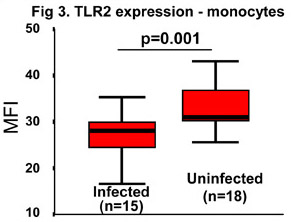
Innate immune receptors; their role in immune regulation. Studies in murine models using MΦ activated with 0-3hRP demonstrate that cytokine production is entirely MyD88-dependent which implies a role for TLRs. Ligation of TLR4 by schistosome ligands should favour the activation of pro-inflammatory cytokines as occurs in response to bacterial LPS. However, dextran-conjugated LNFPIII ligates TLR4 but suppresses IL-12 production by DCs.

These experiments highlight how valuable murine models can be in dissecting which pathways in the innate immune system are involved in pathogen recognition, and are responsible in immunomodulation. Studies in humans, have shown that TLR2 may have a significant role in immunomodulation since Lyso P from schistosome eggs drive DCs to induce Treg cells via a TLR2 dependent mechanism (Fig 2). Interruption of Lyso P binding to TLR2 inhibits the induction of regulatory T cells, indicating that TLRs can play an important role in the generation of immune regulation. Indeed, TLR2 expression is significantly reduced in children infected with schistosomes compared with uninfected age-matched cohorts (Fig 3).  This strongly suggests that TLR2 is repeatedly challenged in helminth infected children, leading to its internalisation in analogy with other systems where repeated stimulation of TLR has led to their down-regulation. It is also possible that glycans in ES products bind cell surface C-type lectins such as DC-specific ICAM-3-grabbing non-integrin (DC-SIGN), or the MR, which in turn modify the activation of TLRs. Binding of pathogen glycans expressing fucose, or LewisX to DC-SIGN on immature DCs can lead to the induction of tolerance, and DC-SIGN binds schistosome egg antigens. Moreover, the binding of ligands to MR can stimulate IL-10 and IL1ra release by DCs that favour the amplification of Th2 circuits. Together, all of these studies highlight the abundance of possible ligand:receptor pairs, each of which may lead to cell activation, or regulation. As yet, very little is known in the human host about innate immune receptors that recognise schistosome molecular patterns, or their immunoregulatory effect on the acquired immune response.
This strongly suggests that TLR2 is repeatedly challenged in helminth infected children, leading to its internalisation in analogy with other systems where repeated stimulation of TLR has led to their down-regulation. It is also possible that glycans in ES products bind cell surface C-type lectins such as DC-specific ICAM-3-grabbing non-integrin (DC-SIGN), or the MR, which in turn modify the activation of TLRs. Binding of pathogen glycans expressing fucose, or LewisX to DC-SIGN on immature DCs can lead to the induction of tolerance, and DC-SIGN binds schistosome egg antigens. Moreover, the binding of ligands to MR can stimulate IL-10 and IL1ra release by DCs that favour the amplification of Th2 circuits. Together, all of these studies highlight the abundance of possible ligand:receptor pairs, each of which may lead to cell activation, or regulation. As yet, very little is known in the human host about innate immune receptors that recognise schistosome molecular patterns, or their immunoregulatory effect on the acquired immune response.